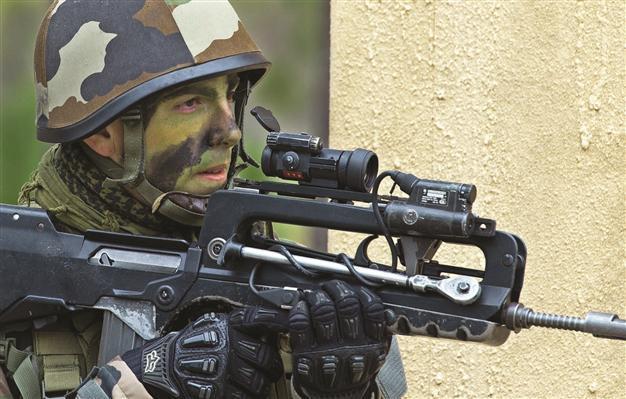EU nations mull sharing arms
Slobodan Lekic - BRUSSELS / The Associated Press

A French army troop conducts urban environment combat in an artificial city after coming ashore last month during Operation Bold Alligator 2012, a multinational military exercise involving forces from 8 countries. AFP Photo
European Union defense ministers yesterday considered pooling their military resources in response to falling defense budgets and a U.S. decision to refocus its strategy on regions beyond Europe.A ministerial meeting yesterday also reviewed current EU operations, including the naval mission off the Somali coastline, the military training program for Somalia’s nascent army, and the peacekeeping operation in Bosnia.
The EU’s 27 governments still spend about 200 billion euros ($265 billion) on defense annually as only the United States spends more. But the fragmentation of military commands and defense industries has made it almost impossible to achieve economies of scale in purchasing military equipment.
Military spending, which has already shrunk 15 percent in the past decade, is set to plunge further as part of the austerity measures implemented by many European governments to cope with the continent’s debt crisis.
Complicating matters further for Europe’s defense planners, the administration of U.S. President Barack Obama has announced a new military strategy that includes a shift away from the Cold War-era focus on Europe. Instead, U.S. military capabilities will in the future concentrate on Asian security risks such as China and North Korea, and build on partnerships in the Middle East to keep an eye on Iran.
Officials said the EU defense ministers were expected to approve recommendations prepared by the EU’s European Defense Agency on joint initiatives in areas such as air-to-air refueling, medical units and logistic support.
Deficiencies
The EDA also is working on a number of programs to address deficiencies identified during the war in Libya, including standardizing the procurement of smart munitions, and developing common intelligence and reconnaissance capabilities.
Participants said a key priority was to extend the anti-piracy mission off Somalia, launched in 2008, because of its success in suppressing pirate attacks. The EU flotilla consists of 5-10 warships, and includes non-EU countries such as Norway, Croatia, Montenegro and Ukraine.
NATO’s Secretary-General Anders Fogh Rasmussen, who also attended the EU meeting, said the military alliance would also probably continue its separate anti-piracy mission, known as Ocean Shield.
“Obviously it’s essential to coordinate closely between the EU operation and the NATO operation,” he said. “In that respect, it is essential to assist countries in the region in capacity-building to deal with counter-piracy themselves.”
On the eve of Nato meeting
The EU defense ministers’ consensus yesterday at a Brussels meeting to pool their military resources was in pace with the NATO defense ministers’ approval on March 3 on a Smart Defense plan, consisting of joint projects that aim to “build greater security with fewer resources but more coordination and coherence.”
The initiatives, proposed by the NATO Secretary General Anders Fogh Rasmussen at the time, include building defense capabilities, based on cutting-edge technology – intelligence, surveillance, reconnaissance as well as logistics and training, in a bid to use resources in a more effective way.
“Allies are discussing a number of projects which will deliver real improvements and make maximum use of the limited resources we have”, Rasmussen said.
The Smart Defense program needs to be ratified by the NATO member states during the upcoming NATO summit in Chicago in May.
















